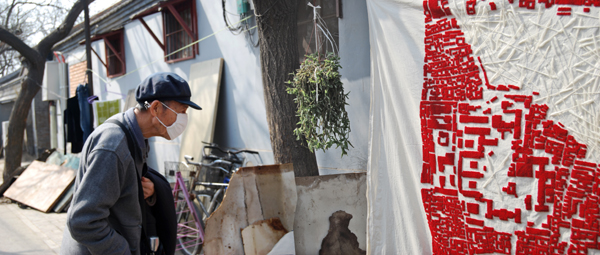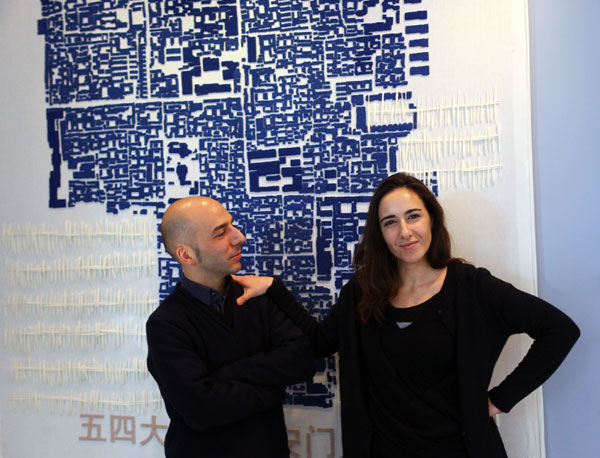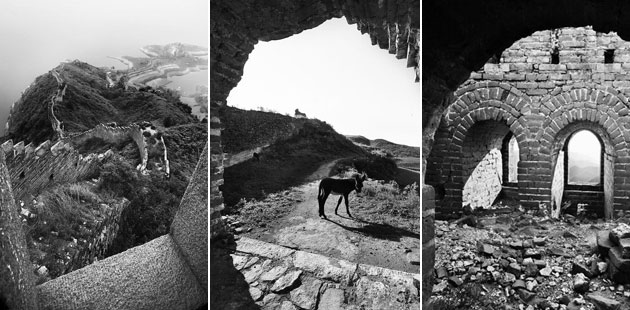Art in Grace
Updated: 2011-12-25 08:07
By Han Bingbin (China Daily)
|
|||||||||
|
Urban carpets were strung out on bamboo poles and hung in the districts they depict, inviting interesting and touching feedback from residents. Provided to China Daily |
|
Stefano Avesani (left) and Marcella Campa pose with an Urban Carpet in the lobby of the Grace Hotel Beijing. Zou Hong / China Daily |
 |
When you are located in the heart of Beijing's most famous art district, you get friendly with your neighbors. Grace Hotel Beijing went a step further. Han Bingbin finds out more.
On the lobby walls of the Grace Hotel Beijing are some huge "maps" you cannot possibly miss.
They are extraordinary maps. On the white canvas, traditional Beijing courtyard houses are tightly squeezed and lined along intricate hutong - embroidered by hand in a woolen tapestry.
Each of the eight Urban Carpet represents a different hutong neighborhood such as Nanluogu Xiang in downtown Beijing. And to add a touch of human warmth, the artists also marked the points of public interaction within the communities.
Stefano Avesani and Marcella Campa are graduates of the Venice Institute of Architecture. They embarked on this unusual project by first learning how to sew - and asked an old woman in Beijing to teach them embroidery, using a technique used in the 1970s for the fabric billboards celebrating Chairman Mao Zedong and the feats of the Party.
What held the year-long project back was the difficulty in collecting data, as local government generally don't give out information easily.
The artists laboriously collected maps from different places, and conducted extensive research in each community.
Often, the maps were incomplete and they had to make a collage from several sources, or had to integrate missing sections with real-life on-site visits.
Many interesting feedback have come back to the artists over the two years. People would point out familiar alleys and relate their own stories. Many were further inspired to share their childhood memories in those lanes. But the most valuable feedback came from people searching out alleys or houses already demolished.
That was when Avesani realized that "changes are usually so fast that as soon as the map is done, the area it depicts has already gone".
That thought gave him the idea for another series called Blinking City, a multimedia installation on rapid urban growth.
It consists of a series of "lenticular" panels containing 14 layers of color which represent the pulse of the people living in hutong. These change color each time someone interacts with them.
Now being exhibited at the Grace Beijing Hotel, both Urban Carpet and Blinking City are part of a package called Instant Hutong - a project that Avesani and Campa started working on in 2005 when they relocated to Beijing.
This series of art pieces and installations bordering on art, social investigation and urban research tries to stimulate and generate open debate.
Avesani explained that their passion for Beijing's hutong is inspired by the fact that it represents a unique way of living which gathers tradition and contemporary, rich and poor, old and new generations together.
His primary concern was that the hutong are constantly threatened by continuous development.
To him, "demolishing your own past means refusing a knowledge which is a result of a living practice". In Italy, he says, people still live in 800-year-old houses which have been upgraded with modern facilities.
"Contemporary does not mean necessarily either deleting the past or freezing it and turning the city into a museum."
He is happy to see several areas of Beijing where the hutong host new activity - such as bars and restaurants, which have renewed and renovated the hutong, giving them new life.
You can contact the writer at hanbingbin@chinadaily.com.cn.













